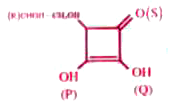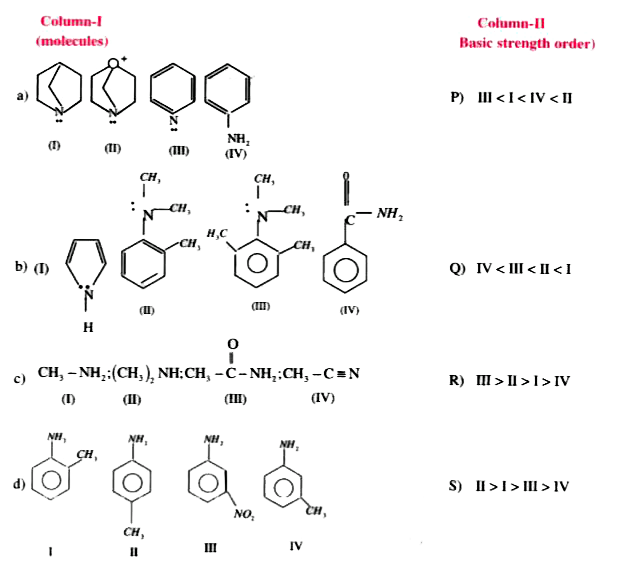The following are more basic than C6H5−NH2Solution in Telugu




The correct Answer is:B, C, D
b and c are elephatic amines where as in d.
L.P. is not in delocalization. so b,c and d are more basic than aniline
Topper's Solved these Questions
- BOOK - AAKASH SERIESCHAPTER - ELECTRONIC EFFECTS AND REACTION INTERMEDIATESEXERCISE - LECTURE SHEET ( EXERCISE-III (LEVEL-II (ADVANCED)) (Linked Comprehension Type Questions)6videos
ELECTRONIC EFFECTS AND REACTION INTERMEDIATES
- BOOK - AAKASH SERIESCHAPTER - ELECTRONIC EFFECTS AND REACTION INTERMEDIATESEXERCISE - LECTURE SHEET ( EXERCISE-III (LEVEL-II (ADVANCED)) (Matrix Matching Type Questions)2videos
ELECTRONIC EFFECTS AND REACTION INTERMEDIATES
- BOOK - AAKASH SERIESCHAPTER - ELECTRONIC EFFECTS AND REACTION INTERMEDIATESEXERCISE - LECTURE SHEET ( EXERCISE-III (LEVEL-II (ADVANCED)) (Straight Objective Type Questions)14videos
ELECTRONIC EFFECTS AND REACTION INTERMEDIATES
- BOOK - AAKASH SERIESCHAPTER - ELECTRON MIGRATION EFFECTS EXERCISE - QUESTIONS FOR DESCRIPTIVE ANSWERS10videos
ELECTRON MIGRATION EFFECTS
- BOOK - AAKASH SERIESCHAPTER - ELEMENTS OF BORON FAMILYEXERCISE - OBJECTIVE EXERCISE - 37videos
ELEMENTS OF BORON FAMILY
Similar Questions
Mesomerism is extended resonance. Atoms or groups with lone pairs of electrons release electrons when connected to doubly bonded carbons. It is +M effect. Unsaturated groups when connected to doubly bonded carbons withdraw π electrons from the doubly bonded carbons. It is -M effect. Here the double bond is the unsaturated group should be between less electronegative atom and more electronegative atom.

Mesomeric effect stabilizes or destabilizes the conjugate base of an acid. As a result the acid may be strong or weak has 4(OH) groups. Which -OH is a strong acid?02:19View Solution
has 4(OH) groups. Which -OH is a strong acid?02:19View SolutionMatch the following columns
 17:01View Solution
17:01View SolutionCorrect gradation of basic character
35:47View SolutionHyperconjugation effect is also termed as 'no bond resonance'. Why?
04:26View SolutionWhich one of the following compounds is not a protonic acid ?
04:21View SolutionArrange the following in decreasing order of their basic strength :
C6H5NH2,C2H5NH2,(C2H5)2NH301:32View SolutionArrange the following in increasing order of their basic strength:
(i) C2H5NH2,C6H5NH2,NH3,C6H5CH2NH2and(C2H5)2NH
(ii) C2H5NH2,(C2H5)2NH,(C2H5)3N,C6H5NH2
(iii) CH3NH2,(CH3)2NH,(CH3)3N,C6H5CH2NH2.01:20View SolutionArrange the following: (i) In decreasing order of the pK_(b) values: C_(2)H_(5)NH_(2),C_(6)H_(5)NHCH_(3),(C_(2)H_(5))_(2)NHandC_(6)H_(5)NH_(2) (ii) In increasing order of basic strength: C_(6)H_(5)NH_(2),C_(6)H_(5)N(CH_(3))_(2),(C_(2)H_(5))_(2)NH andCH_(3)NH_(2) (iii) In increasing order of basic strength: (a) Aniline, p-nitroaniline and p-toluidine (b) C_(6)H_(5)NH_(2),C_(6)H_(5)NHCH_(3),C_(6)H_(5)CH_(2)NH_(2) (iv) In decreasing order of basic strength in gas phase: C_(2)H_(5)NH_(2),(C_(2)H_(5))_(2)NH,(C_(2)H_(5))_(3)NandNH_(3) (v) In increasing order of boiling point: C_(2)H_(5)OH,(CH_(3))_(2)NH,C_(2)H_(5)NH_(2) (vi) In increasing order of solubility in water: C_(6)H_(5)NH_(2),(C_(2)H_(5))_(2)NH,C_(2)H_(5)NH_(2^.)
View Solutionनिम्नलिखित को क्षारकीय प्राबल्य के घटते क्रम में लिखिए-
C6H5NH2,C2H5NH2,(C2H5)2NH,NH3View Solutionनिम्नलिखित को क्रम में लिखिए-
(i) pKb मान के घटते क्रम में -
C2H5NH2,C6H5NHCH3,(C2H5)2NH एवं C6H5NH2
(ii) क्षारकीय प्राबल्य के घटते क्रम में-
C6H5NH2,C6H5(CH3)2,(C2H5)2NH एवं C6H5NH2
(iii) क्षारकीय प्राबल्य के बढ़ते क्रम में- (क) ऐनिलीन , पैरा – नाइट्रोऐनिलीन ,एवं पैरा-टॉलूईन
(ख) C6H5NH2,C6H5NHCH3,C6H5CH2NH2
(iv) गैस अवस्था में घटते हुए क्षारकीय प्राबल्य के क्रम में-
C6H5NH2,(C2H5)2NH,(C2H5)3N एवं NH3
(v) क्वथनांक के बढ़ते क्रम में-
C6H5ON,(CH3)2NH,C2H5NH2
(vi) जल में विलेयता के बढ़ते क्रम में-
C6H5OH,(CH3)2NH,C2H5NH203:36View SolutionArrange the following in decreasing order of their basic strength: C6H5NH2,C2H5NH2,(C2H5)2NH,NH3 in aqueous solution.
02:19View SolutionNH3,C6H5NH2 से अधिक क्षारीय है, क्यों ?
02:19View Solutionनिम्नीकरण को क्षारकीय प्राबल्य ( प्रबलता ) के घटते क्रम में लिखिए -
C6H5NH2,C2H5NH2,(C2H5)2NH,NH3.03:44View Solutionनिम्नलिखित को क्रम में लिखिए -
(i) pKb मान के घटते क्रम में -
C2H5NH2,C6H5NHCH3,(C2H5)2NHएवं C6H5NH2
(ii) क्षारकीय प्राबल्य के घटते क्रम में -
C6H5NH2,C6H5N(CH3)2,(C2H5)2NH एवं CH3NH2
(iii) क्षारकीय प्राबल्य के बढ़ते क्रम में -
(a) ऐनिलीन , पैरा - नाइट्रोऐनिलीन एवं पैरा-टोलूडीन
(b) C6H5NH2,C6H5NHCH3,C6H5CH2NH2
(iv) गैस अवस्था में घटते हुए क्षारकीय प्राबल्य के क्रम में -
C2H5OH,(C2H5)2NH,(C2H5)3N एवं NH3
(v) क्वथनांक के बढ़ते क्रम में -
C2H5OH,(CH3)2NH,C2H5NH2
(vi) जल में विलेयता के बढ़ते क्रम में -
C6H5NH2,(C2H5)2NH,C2H5NH2.08:16View SolutionArrange the following in decreasing order of their basic strength :
C6H5NH2,C2H5NH2,(C2H5)2NH,NH303:22View SolutionArrange the following in increasing order of their basic strength.
C2H5NH2,C6H5NH2,NH3,C6H5CH2NH2and(C2H5)2NH01:25View Solution

